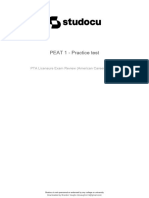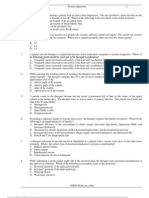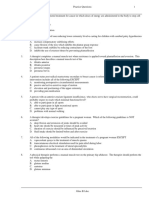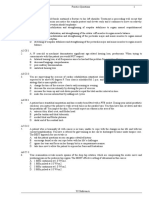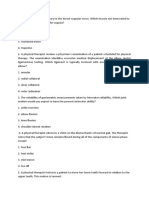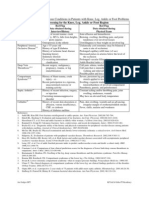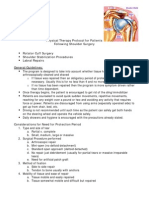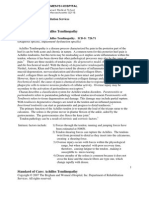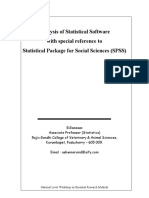0 ratings0% found this document useful (0 votes)
80 viewsExercise
A patient is asked to rate his level of exertion using the Borg Rating of Perceived Exertion Scale (RPE) a rating of 9 corresponds to very, very light. B. Hard. C. Very light. D. Somewhat hard.
Uploaded by
ShrutiCopyright
© Attribution Non-Commercial (BY-NC)
Available Formats
Download as PDF or read online on Scribd
0 ratings0% found this document useful (0 votes)
80 viewsExercise
A patient is asked to rate his level of exertion using the Borg Rating of Perceived Exertion Scale (RPE) a rating of 9 corresponds to very, very light. B. Hard. C. Very light. D. Somewhat hard.
Uploaded by
ShrutiCopyright
© Attribution Non-Commercial (BY-NC)
Available Formats
Download as PDF or read online on Scribd
You are on page 1/ 5
CHAPTER 17. THERAPEUTIC EXERCISE 1178,
Comprehension Questions
. What type of contraction occurs when there is tension produced in the muscle with-
out any appreciable change in muscle length or joint movement?
What type of contraction occurs when a muscle slowly lengthens as it gives in to an
external force that is greater than the contractile force it is exerting?
. Of the three types of muscle actions—isometric, concentric and eccentric—which
one is capable of developing the most force?
4. What are the four biomechanical properties that human skeletal muscle possesses?
.. True or false: Rapid lengthening contractions generate less force than do slow ones
(slower lengthening contractions).
A. True,
B. False.
6. Give two disadvantages of isometric exercise.
7. What is the best way to first exercise the postural (or extensor) musculature when it
is extremely weak to facilitate muscle control?
A. Eccentric exercises.
B. Isometric exercises.
C. Isokinetic exercises.
D. Electrical stimulation,
8. What are the four parameters of exercise?
9. What is the best gauge of exercise intensity in a healthy individual?
A. Blood pressure,
B. Heart rate.
C. Rating of perceived exertion,
D. Rate of perspiration.
10. You ask a patient to assess his level of exertion using the Borg Rating of Perceived
Exertion Scale (RPE). The patient rates the level of exertion as 9 on the 6 to 19 scale.
A rating of 9 corresponds to which ofthe following?
A. Very, very light.
B. Hard
C. Very light.
D. Somewhat hard.
11. The optimal exercise prescription to improve fast movement speeds and enhance
endurance (improving fast-twitch fiber function) is:
A. Low-intensity workloads for short durations.
B. High-intensity workloads for short durations.
C. Low-intensity workloads for long durations.
D. High-intensity workloads for long durations.
1176
SECTION I, PROCEDURAL INTERVENTIONS
12.
You have been asked to develop an exercise plan for a prsgrant woman The
strengthening of which of the following muscles should be the focus to maintain a
strong pelvic floor?
A. Rectus abdominis, iliococcygeus, and piriformis.
B. Piriformis, obturator internus, and pubococcygeus.
C. lliococcygeus, pubococcygeus, and coccygeus
D. Obturator internus, piriformis, and external obliques.
. A 35-year-old presents with a prescription to improve aerobic conditioning. Which
of the following is not a benefit of aerobic exercise?
A. Improved cardiovascular fitness.
B. Increased high-density lipoprotein (HDL) cholesterol.
C. Improved ilexibility
D. Improved state of mind.
You are treating a 15-year-old male soccer player who sustained a grade Il inversion
ankle sprain 2 weeks ago. You determine that the patient is now in the early suba-
cute phase of rehabilitation. Which of the following interventions should the patient
be performing?
‘A. Closed-chain lower extremity strengthening, proprioceptive exercises, and an
orthosis.
B. Weaning off crutches to a cane.
C. Protection, rest, ice, compression, and elevation (PRICE}.
D. Open-chain lower extremity exercises only,
. You are planning the intervention for a 73-year-old inpatient who received a
cemented total hip replacement 2 days ago. Your plan of care should focus on
A. Patient education regarding positions and movements to avoid.
B, Active range-of-motion exercises and early ambulation using a walker.
C. Passive range-of-motion exercises.
D. Tilt table.
. Your first patient of the day has been referred with a prescription stating Stable
humeral neck fracture—Begin functional mobility. After the examination you decide
the best initial intervention for this patient is:
A. Pendulum exercises.
B. Shoulder isometrics.
C. Manual PNF.
D. Modalities to control pain.
. You are treating a patient who has been referred to physical therapy to be set up on
an exercise program to assist in weight loss. Which type of exercise program promotes
weight loss?
. You have decided to implement PNF exercises with a patient recovering from
impingement syndrome of the shoulder. What is the best PNF diagonal pattern to
improve function of the shoulder?
A. D1 flexion,
B. D1 extension.
C. D? flexion.
D. D2 extension.
20.
21.
22.
23,
24,
25.
(CHAPTER 17, THERAPEUTIC EXERCISE 1177
. You are planning the intervention for a patient with acute rotator cuff tendonitis and
subacromial bursitis. During your examination you found that passive and active
glenohumeral motions increased the patient's pain. Your initial intervention should be:
A. To use modalities to reduce pain and inflammation.
B. To begin rotator cuff strengthening exercises.
C. To begin correcting any muscle imbalances.
D. Shoulder isometrics.
You have been asked to teach a class at a local gym for a group of geriatric athletes,
Which of the following is not a general guideline for exercise prescription in this
patient population?
‘A. Use machines for strength training rather than free weights.
B. Always warm-up prior to exercise.
C. No pain, no gain.
D. Try to incorporate both aerobic and anaerobic exercises.
You are assisting a patient in improving anterior stability of the knee joint using exer-
cises to strengthen muscle groups that will assist the anterior cruciate ligament.
Which of the folowing muscle groups provides the most amount of active restraint?
A. Gastrocnemius.
B, Hamstrings.
C. Quadriceps,
D. Hip adductors.
You decide to use a contract-relax technique to improve a patient’s active straight les
raise. Which of the following muscle groups should you emphasize the contraction of
A. Hip abductors and hip Hlexos.
B. Hamstrings and hip extensors,
C. Quadriceps and hip flexors.
D. Hip abductors and quadriceps.
Which of the following exercises is indicated to enhance coordination?
‘A. Codman’s exercises.
B. McKenzie exercises.
C. Frenkel's exercises.
D. Williams exercises.
You have been referred a patient with a prescription that reads Knee strengthening —
Open-chain exercises only. Which of the following is not an open chain exercise?
A. Knee extension.
B. Hamstring curls.
C. Squat.
D. Straight leg raise.
A high school coach asks you what is the best type of exercise to improve an ath-
lete’s vertical jump. Which of the following exercise types would be the best to
achieve this goal?
A. Closed hain,
B. Open chain.
C. Plyometrics.
D. DeLorme's.
1178
SECTION il, PROCEDURAL INTERVENTIONS
26. Give three contraindications to aquatic exercise.
27, What should the water temperature be for water exercise?
28. You have been asked to set up an exercise program for an obese patient who is
74 pounds overweight and is recovering from a mild myocardial infarction. The
Most appropriate exercise prescription for this patient is:
‘A. Walking at an intensity of 50% of the patient's maximum heart rate.
B. Jogging at an intensity of 60% of the patient's maximum heart rate.
C. Swimming at an intensity of 75% of the patient's maximum heart rate.
D. No exercise with a focus on diet.
29. You are treating a patient who is beginning recovery stage 4 movements following a
right CVA. Which PNF pattern should you use to promote continued recovery of the
{eft upper extremity through the use of out-of-synergy movements?
A. Bilateral symmetrical D1 thrust and reverse thrust.
B. Chop, reverse chop with the left upper extremity leading.
C. Bilateral symmetrical D2 thrust and reverse thrust.
D. Lif reverse lift with the left upper extremity leading.
30, You have been asked to design an exercise program for a 46-year-old individual who
has limited endurance as a result of a sedentary lifestyle. There is no history of car-
diorespiratory problems. An appropriate initial exercise intensity for this individual
would be:
A. 30% to 60% of the maximum heart rate.
B. 60% to 90% of the maximum heart rate.
C. 10% to 30% of the maximum heart rate.
D. 0% to 30% of the maximum heart rate.
Answers
1. Isometric contraction.
. Eccentric.
Eccentric.
. Extensibility, elasticity, irritability, and the ability to develop tension.
The answer is B. This statement is false.
Se ReRN
. The strength gains are developed at a specific point in the range of motion and not
throughout the range; not all of a muscle’s fibers are activated.
7. The answer is B.
8. Typelmode of exercise, intensity, duration, and frequency
9. The answer is B.
10. The answer is C.
11. The answer is B.
14
15.
16.
17,
18,
20.
21,
22.
23,
24.
25.
26.
27.
28.
29.
30.
CHAPTER 17. THERAPEUTIC EXERCKE 1179
. The answer is C.
13.
The answer is B,
The answer is A.
The answer is A.
The answer is A.
Exercise of low intensity and long duration.
The answer is C.
The answer is A.
The answer is C.
The answer is B.
The answer is B.
The answer is C.
The answer is C.
The answer is C.
Any three of the following: incontinence, urinary tract infections, unprotected open
wounds, heat intolerance, severe epilepsy, uncontrolled diabetes, unstable blood
pressure, or severe cardiac and/or pulmonary dysfunction.
92 to 95°F.
The answer is A.
The answer is B.
The answer is A.
You might also like
- Test Bank For Therapeutic Exercise Foundations and Techniques 6th Edition by Kisner64% (14)Test Bank For Therapeutic Exercise Foundations and Techniques 6th Edition by Kisner6 pages
- Model Test Paper For MPT Entrance Examinations81% (27)Model Test Paper For MPT Entrance Examinations4 pages
- Pot 403 Exercise Therapy, Therapeutic, Fitness & SportsNo ratings yetPot 403 Exercise Therapy, Therapeutic, Fitness & Sports118 pages
- Files Research Question Partb PhysiotherapyNo ratings yetFiles Research Question Partb Physiotherapy6 pages
- giles-a107-sullivan-a-practice-questions-20212022No ratings yetgiles-a107-sullivan-a-practice-questions-2021202228 pages
- Old Chronologically and Cognitively, But at A 6-Month-Old Gross Developmental Level Would IncludeNo ratings yetOld Chronologically and Cognitively, But at A 6-Month-Old Gross Developmental Level Would Include20 pages
- Test Bank For Therapeutic Exercise Foundations and Techniques 6th Edition by Kisner All Chapter Instant Download100% (3)Test Bank For Therapeutic Exercise Foundations and Techniques 6th Edition by Kisner All Chapter Instant Download30 pages
- Get the entire Test Bank for Therapeutic Exercise Foundations and Techniques 6th Edition by Kisner in PDF with one simple click.100% (9)Get the entire Test Bank for Therapeutic Exercise Foundations and Techniques 6th Edition by Kisner in PDF with one simple click.12 pages
- 020-222 ACSM Health/Fitness Instructor ExamNo ratings yet020-222 ACSM Health/Fitness Instructor Exam22 pages
- Test Bank for Therapeutic Exercise Foundations and Techniques, 6th Edition : Kisner - Download Instantly To Explore The Full Content100% (6)Test Bank for Therapeutic Exercise Foundations and Techniques, 6th Edition : Kisner - Download Instantly To Explore The Full Content41 pages
- Test Bank for Therapeutic Exercise Foundations and Techniques, 6th Edition : Kisner PDF Download Full Book with All Chapters100% (8)Test Bank for Therapeutic Exercise Foundations and Techniques, 6th Edition : Kisner PDF Download Full Book with All Chapters41 pages
- Test Bank for Therapeutic Exercise Foundations and Techniques, 6th Edition : Kisner - Read Directly Or Download With One Click100% (3)Test Bank for Therapeutic Exercise Foundations and Techniques, 6th Edition : Kisner - Read Directly Or Download With One Click38 pages
- Part 1 - Pregnancy, Childbirth and The NewbornNo ratings yetPart 1 - Pregnancy, Childbirth and The Newborn57 pages
- Physical Therapy Protocols - Knee Conditions100% (1)Physical Therapy Protocols - Knee Conditions120 pages
- Tamizh Translation of McGill Pain Questionnaire100% (1)Tamizh Translation of McGill Pain Questionnaire4 pages
- Physical Therapy Protocols For Conditions of Elbow RegionNo ratings yetPhysical Therapy Protocols For Conditions of Elbow Region96 pages
- Physical Therapy Protocols For Conditions of Thorax RegionNo ratings yetPhysical Therapy Protocols For Conditions of Thorax Region52 pages
- Physical Therapy Protocols For Conditions of Shoulder Region100% (1)Physical Therapy Protocols For Conditions of Shoulder Region111 pages
- Physical Therapy Protocols For Conditions of The Low Back RegionNo ratings yetPhysical Therapy Protocols For Conditions of The Low Back Region76 pages
- Physical Therapy Protocols For The Conditions of Hip Region100% (1)Physical Therapy Protocols For The Conditions of Hip Region50 pages
- Physical Therapy Protocols For Ankle and Foot ConditionsNo ratings yetPhysical Therapy Protocols For Ankle and Foot Conditions116 pages
- Lower Extremity Physical Therapy Exercises100% (1)Lower Extremity Physical Therapy Exercises13 pages
- Shoulder Post-Operative Rehabilitation ProtocolsNo ratings yetShoulder Post-Operative Rehabilitation Protocols6 pages
- Upper Extremity Physical Therapy ExercisesNo ratings yetUpper Extremity Physical Therapy Exercises14 pages
- Orthopedics Standard of Care GuidelinesNo ratings yetOrthopedics Standard of Care Guidelines543 pages
- Analysis of Statistical Software With Special Reference To Statistical Package For Social Sciences (SPSS)No ratings yetAnalysis of Statistical Software With Special Reference To Statistical Package For Social Sciences (SPSS)29 pages
- Brigham & Women's Hospital - Return To Sports Guidelines100% (1)Brigham & Women's Hospital - Return To Sports Guidelines17 pages
- Brigham & Women's Hospital - Knee Rehabilitation PT ProtocolsNo ratings yetBrigham & Women's Hospital - Knee Rehabilitation PT Protocols27 pages
- Brigham & Women's Hospital - Elbow & Hand Rehabilitation PT ProtocolsNo ratings yetBrigham & Women's Hospital - Elbow & Hand Rehabilitation PT Protocols25 pages
- How To Conduct A Literature Search - An OverviewNo ratings yetHow To Conduct A Literature Search - An Overview39 pages
- Test Bank For Therapeutic Exercise Foundations and Techniques 6th Edition by KisnerTest Bank For Therapeutic Exercise Foundations and Techniques 6th Edition by Kisner
- Pot 403 Exercise Therapy, Therapeutic, Fitness & SportsPot 403 Exercise Therapy, Therapeutic, Fitness & Sports
- Old Chronologically and Cognitively, But at A 6-Month-Old Gross Developmental Level Would IncludeOld Chronologically and Cognitively, But at A 6-Month-Old Gross Developmental Level Would Include
- Test Bank For Therapeutic Exercise Foundations and Techniques 6th Edition by Kisner All Chapter Instant DownloadTest Bank For Therapeutic Exercise Foundations and Techniques 6th Edition by Kisner All Chapter Instant Download
- Get the entire Test Bank for Therapeutic Exercise Foundations and Techniques 6th Edition by Kisner in PDF with one simple click.Get the entire Test Bank for Therapeutic Exercise Foundations and Techniques 6th Edition by Kisner in PDF with one simple click.
- Test Bank for Therapeutic Exercise Foundations and Techniques, 6th Edition : Kisner - Download Instantly To Explore The Full ContentTest Bank for Therapeutic Exercise Foundations and Techniques, 6th Edition : Kisner - Download Instantly To Explore The Full Content
- Test Bank for Therapeutic Exercise Foundations and Techniques, 6th Edition : Kisner PDF Download Full Book with All ChaptersTest Bank for Therapeutic Exercise Foundations and Techniques, 6th Edition : Kisner PDF Download Full Book with All Chapters
- Test Bank for Therapeutic Exercise Foundations and Techniques, 6th Edition : Kisner - Read Directly Or Download With One ClickTest Bank for Therapeutic Exercise Foundations and Techniques, 6th Edition : Kisner - Read Directly Or Download With One Click
- Physical Therapy Protocols For Conditions of Elbow RegionPhysical Therapy Protocols For Conditions of Elbow Region
- Physical Therapy Protocols For Conditions of Thorax RegionPhysical Therapy Protocols For Conditions of Thorax Region
- Physical Therapy Protocols For Conditions of Shoulder RegionPhysical Therapy Protocols For Conditions of Shoulder Region
- Physical Therapy Protocols For Conditions of The Low Back RegionPhysical Therapy Protocols For Conditions of The Low Back Region
- Physical Therapy Protocols For The Conditions of Hip RegionPhysical Therapy Protocols For The Conditions of Hip Region
- Physical Therapy Protocols For Ankle and Foot ConditionsPhysical Therapy Protocols For Ankle and Foot Conditions
- Analysis of Statistical Software With Special Reference To Statistical Package For Social Sciences (SPSS)Analysis of Statistical Software With Special Reference To Statistical Package For Social Sciences (SPSS)
- Brigham & Women's Hospital - Return To Sports GuidelinesBrigham & Women's Hospital - Return To Sports Guidelines
- Brigham & Women's Hospital - Knee Rehabilitation PT ProtocolsBrigham & Women's Hospital - Knee Rehabilitation PT Protocols
- Brigham & Women's Hospital - Elbow & Hand Rehabilitation PT ProtocolsBrigham & Women's Hospital - Elbow & Hand Rehabilitation PT Protocols




